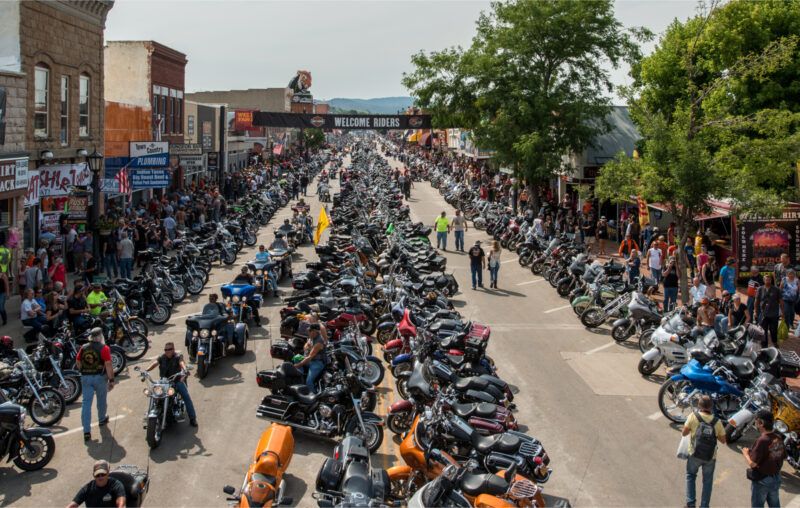The Sturgis Bike Rally, Sensationalist Reporting, and Broken Disease Models

More than 460,000 individuals flocked to Sturgis, South Dakota, for the 10-day Sturgis Motorcycle Rally in August participating in an event where there was a general disregard for mask-wearing and social distancing protocols.
Governor Kristi Noem welcomed and celebrated the event, while continuing to defend the state’s no-lockdown policies.
Recently and not surprisingly, the media has been throwing around an astounding assertion, that this was a “superspreader event” and that a study shows that it has been linked to over 266,000 COVID-19 cases.
Headlines such as this Mother Jones article read: “Sturgis Motorcycle Rally Is Now Linked to More Than 250,000 Coronavirus Cases.”
Yahoo News published an article titled: “Sturgis motorcycle rally was a ‘superspreader event.’”
A more moderate title from US News reads “Report: Sturgis Motorcycle Rally May Have Caused Over 250,000 Coronavirus Cases.”
Everywhere you look you find some sort of sensational headline touting the findings of the report. This report was written by researchers who at
“San Diego State University’s Center for Health Economics & Policy Studies sought to quantify the rally’s Covid impact in South Dakota and nationwide by analyzing the (anonymous) cell-phone data of attendees. They then compared case trends in counties with high, moderate and low numbers of attendees.”
The study, although it was likely conducted with good intentions, according to Yahoo News
It is not clear if the study was subject to peer review.
Furthermore, the study was conducted by a team of economists, not epidemiologists (not that they have been correct about Covid-19 either) which should also raise a few eyebrows.
Fact-Checking
According to a report published by Jennifer Dowd, deputy director of the Leverhulme Centre for Demographic Science at the University of Oxford, this 250,000 case number is likely false. Dowd is also part of a group called Dear Pandemic, which spends much of its time clarifying and explaining information regarding Covid-19.
At best the 250,000 estimate is the absolute worst-case scenario but the real number based on contact tracing is likely in the hundreds. It is worth noting that our contact tracing capabilities are limited and the science behind the practice itself has its problems. Dowd writes
Modeling infection transmission dynamics is hard, as we have seen by the less than stellar performance of many predictive COVID-19 models thus far.
AIER has written extensively on the failures of modeling to predict real-world outcomes and how predictions created by oversimplistic computer models just don’t stand up to reality. You can find a collection of our reports on the matter here.
Such simplistic and misleading models produced by researchers at respectable institutions are frequently used by narrative peddlers of all types from politicians to the media. Phil Magness gives a recent example of a thoroughly discredited report leveraged by President Trump for such a purpose when he writes
Citing the now-infamous March 16th ICL report by Imperial’s Neil Ferguson, the American president now regularly claims vindication for his own support of the lockdowns on account of the difference between its 2 million-plus projected death toll and the actual count of just over 100,000 as of this writing.
Jennifer Dowd says the following on the methodology used to achieve the 266,000 figure touted by the Sturgis report.
“The Sturgis study essentially tries to re-create a randomized experiment by comparing the COVID-19 trends in counties that rallygoers traveled from with counties that apparently don’t have as many motorcycle enthusiasts. The authors estimate the source of inflow into Sturgis during the rally based on the “home” location of nonresident cellphone pings. They use a “difference-in-difference” approach, calculating whether the change in case trends for a county that sent many people to Sturgis was larger compared with a county that sent none. They looked at how cumulative case numbers changed between June 6 and Sept. 2.
While this approach may sound sensible, it relies on strong assumptions that rarely hold in the real world.”
Dowd continues to take issue with the methodology when she writes
“Since attendees hardly had time to attend the rally, get infected, and then bike home and infect others, the fact that rates in large sending counties are higher than those for non-sending counties strongly suggests that these differences in trends were in the works anyway due to local transmission dynamics, and not a direct result of the rally.”
The governor of South Dakota, Kristi Noem, long a target for her anti-lockdown stance puts it more bluntly when she says
“Well, that’s actually not factual whatsoever,” Noem said of the study.
“What they did is, they took a snapshot in time, and they did a lot of speculation, did some back-of-the-napkin math, made up some numbers and published them.”
Whether you prefer the blunt response from governor Noem or the elaborate detail provided by Dr. Dowd as well as AIER’s scholars, the message is the same as it has been for countless other epidemiological models. Trusting the technology and methods employed to predict something as complex as the spread of infectious disease, especially those that we still do not fully understand is futile as well as a dangerous endeavor.
The Daily Beast quotes Dr. Jeffrey Klausner who finds the study to be “plausible” but they also write
Klausner did take issue with the study’s estimate that the additional cases generated public health costs of $12.2 billion. He termed the number “absurd,” observing that it was generated by what the study terms that “the statistical cost of COVID-19 case of $46,000.”
Although we should still continue to monitor the situation and take scientific studies such as the report about the Sturgis rally seriously, the results cannot be seen as truly reliable at this time if at all. The fact that the media has been so quick to sensationalize the study is extremely concerning and not productive.
A Note On Sensational Science
Although it would be great to end the article here, sadly this case is just one of many questionable and likely politicized scientific studies regarding Covid-19. In particular, the media and even parts of the scientific community have literally politicized what types of gatherings spread Covid-19 and which do not.
We hear over and over again that anti-lockdown protests spread COVID-19, which on its face seems reasonable because there are large numbers of people grouping in one place.
A headline from The Guardian reads “US lockdown protests may have spread virus widely, cellphone data suggests.”
However, the public health community and the media seem to believe that for some reason Black Lives Matter protests don’t do so as well. A headline from Health Line reads “Why the Black Lives Matter Protests Didn’t Contribute to the COVID-19 Surge.”
Although that article may try to rationalize its headline, some public health experts are more forthcoming with their willingness to politicize their findings as the New York Times reports that a
“Letter signed by more than 1,300 epidemiologists and health workers urged Americans to adopt a “consciously anti-racist” stance and framed the difference between the anti-lockdown demonstrators and the protesters in moral, ideological and racial terms.”
This is concerning for a variety of reasons, the main one being the politicization of science. It is not unlikely that the Sturgis Motorcycle Rally would fall into the category of mass gatherings that are deemed to be politically unfavorable and therefore contribute to Covid-19. Such practices should be left in the totalitarian regimes that they came from.
Dowd offers some commentary on this issue when she writes
“The authors of this study have used the same study design to estimate the effects of other mass gatherings including the BLM protests and Trump’s June Tulsa, Oklahoma rally. Each paper has given some part of the political spectrum something they might want to hear but has done very little to illuminate the actual risks of COVID-19 transmission at these events”.
Final Thoughts
At the moment we should view the headlines touting six figure transmission numbers as extremely misleading. It is possible, although probably unlikely, that the numbers do turn out to be correct but the evidence seems to say otherwise. Just look at the previous predictions regarding the spread and lethality of Covid-19 and other diseases. They have been wrong time and time again. Perhaps one day we will have widespread reliable and trustworthy epidemiological modeling practices, but today is not that day.
However, this issue is illustrative of a larger and more concerning practice, the politicization of public health. Biker rallies and Trump events are super-spreaders but countrywide racial justice protests aren’t. If you thought the debate about climate change was irritating, wait till you see where this takes us.
Dr. Dowd sums this up more eloquently when she writes
“Exaggerated headlines and cherry-picking of results for “I told you so” media moments can dangerously undermine the long-term integrity of the science—something we can little afford right now.”
I would like to be one of the first to say that I will gladly accept the findings of the Sturgis study if an appropriate amount of evidence and scrutiny can confirm it. However, at this time it has been questioned if not debunked by leading specialists in the field. Furthermore, it shares eerie conformity to the politicized and sensational reporting on Covid-19 that the country would do best without.
By reevaluating the methodology used to report on the Sturgis rally, Black Lives Matter protests, anti-lockdown protests, Trump rallies, and so on, we can reach some more productive conclusions. There are certain things that are so significant and the tradeoffs favorable enough that they are worth braving a pandemic, such as Woodstock.
Or maybe we should take a step back, take a deep breath, and reevaluate the way we go about all of this.










